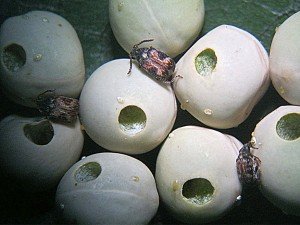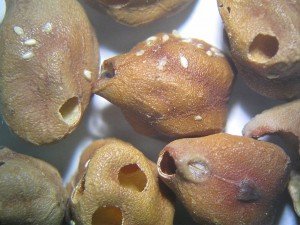There have been two reports recently of cowpea bruchid activity, with these pests infesting pulse crops in the field prior to harvest. The first report concerned the cowpea bruchid (weevil) Callosobruchus maculatus in field peas from Goondiwindi. The bruchids were noticed at intake and continued to breed in an untreated grain sample post-harvest. This clearly indicated they were not pea weevils (bruchids) Bruchus pisorum, which do not breed in stored grain.

Cowpea bruchid (weevil) adults (3mm) in field peas, harvested 16/10 Goondiwindi and noticed at intake on 17/10. They continued to breed in the seed sample.
The second report was of the closely related Callosobruchus phaseoli, also known as cowpea bruchids, in chickpeas at Moura. This is the first time this particular species has been found in chickpeas in Queensland although C. maculatus has been frequently reported in this crop. The bruchids in chickpeas were dead at intake, most likely because the crop was frosted prior to harvest in Sept 2014.
In view of these reports, it is recommended that growers check their pulse crops in the field for seed damage and during harvest by sieving grain. A sub sample of grain at harvest time should be kept in a container as a reference sample. Keep this in a warm ‘place’ to check for post-harvest breeding from undetected bruchid eggs or other life cycle stages. If the sample is kept at around 30 °C and is still bruchid free after 30 days, it is almost certainly clear of insects. This sample serves as an early post-harvest warning of bruchids present, but not detectable at harvest/intake. In all cases, always ensure insects are correctly identified.
If a bruchid problem is evident, store grain in an aerated, sealable silo. For spring and summer pulse harvest times, when bruchid detections indicate a low level infestation, undertake standard aeration cooling procedures for the first two weeks of storage to create uniform moisture conditions in the freshly harvest grain. This puts the grain in a safe condition prior to sealing up the silo for fumigation.
Grain temperatures should come down from 30 to 35°C at harvest, to 20 to 23°C following aeration. Having used a pressure test to check the silo is gas tight, now conduct a 10 day phosphine fumigation to kill all life stages of the bruchid infestation.
For more information:
- GRDC Fact sheet Storing Pulses March 2012
- Plant Health Australia website: fact sheet on Exotic Bruchids
Article by Hugh Brier and Philip Burrill
Images by Joe Wessels

